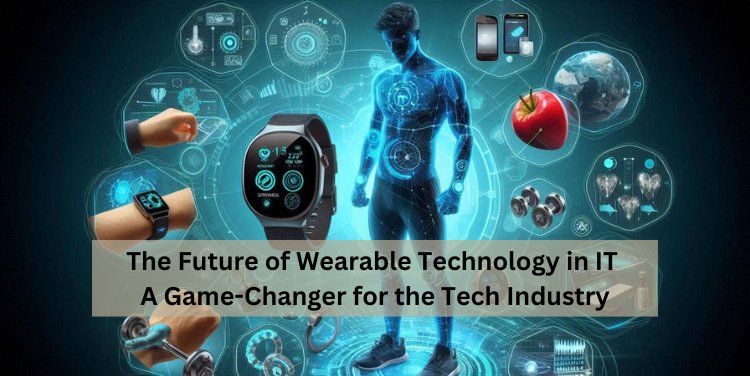The Future of Wearable Technology in IT: A Game-Changer for the Tech Industry

In recent years, wearable technology has moved from being a niche product to becoming a significant part of the global consumer market. From smartwatches and fitness trackers to augmented reality (AR) glasses and even smart clothing, wearables are revolutionizing the way we interact with technology. As we look ahead, the role of wearable tech in the IT industry is expected to expand, introducing new opportunities and challenges for businesses, developers, and consumers alike.
Let’s explore the future of wearable technology in IT and what it holds for the tech landscape.
1. The Rise of Health and Fitness Wearables
The health and wellness sector has been one of the most prominent drivers of wearable technology. Devices like the Apple Watch, Fitbit, and Oura Ring allow users to monitor their heart rate, track sleep patterns, measure physical activity, and even detect potential health issues. In the future, we can expect wearables to become even more advanced with sensors that can monitor blood glucose levels, hydration, stress levels, and even detect early signs of conditions like cancer or heart disease.
IT professionals will play a key role in integrating health data with healthcare systems, ensuring secure data storage, and ensuring compliance with regulations such as HIPAA (Health Insurance Portability and Accountability Act). Wearables will also leverage machine learning (ML) and artificial intelligence (AI) to provide real-time insights into personal health, which could result in more proactive healthcare management.
2. The Integration of Augmented and Virtual Reality (AR/VR)
Augmented Reality (AR) and Virtual Reality (VR) are two major areas where wearable technology is expected to make a significant impact. Devices like Microsoft’s HoloLens and Magic Leap are already showcasing the potential of AR glasses, which can overlay digital information on the real world.
In IT, AR and VR wearables are set to transform industries such as education, training, design, and remote work. Imagine engineers being able to visualize 3D models of buildings or machinery on-site, or students using AR glasses for immersive learning experiences. In remote work, VR headsets will enable virtual meetings in collaborative virtual spaces, breaking the barriers of traditional video conferencing.
For IT professionals, this opens up a new wave of opportunities in app development, UX/UI design, cloud computing, and data security. The integration of AR and VR will require seamless real-time processing of large amounts of data, which will drive the need for faster networks and edge computing.
3. Wearables for Enterprise Use
While wearables are commonly associated with personal use, there is growing interest in how they can benefit enterprises. In industries like logistics, manufacturing, and healthcare, wearables can boost productivity and improve safety. For example, smart helmets or AR glasses can assist factory workers by providing real-time data, instructions, and hazard alerts, enhancing safety and reducing errors.
IT departments will need to ensure that these devices are integrated into existing enterprise systems, which involves creating robust back-end architectures, data synchronization, and real-time analytics. Additionally, wearables can enhance employee engagement and performance by providing real-time insights into productivity, health, and well-being.
4. The Evolution of Wearable Payment Systems
Wearable devices are also likely to play a major role in the future of payments. Smartwatches and fitness bands have already introduced contactless payments via NFC (Near Field Communication) technology, enabling users to make purchases with a simple tap. As the adoption of wearable payment systems grows, this technology will evolve to offer even more secure, faster, and convenient payment options.
For IT professionals, the integration of wearables with digital wallets and payment gateways will become a key aspect of cybersecurity. Developers will need to ensure that payment systems on wearables are encrypted and comply with global financial regulations.
5. Data Privacy and Security Challenges
As wearable technology collects an ever-increasing amount of personal data, the need for strong data privacy and security measures will only intensify. Whether it’s health data, location tracking, or personal preferences, wearables are constantly gathering sensitive information that could be targeted by cybercriminals.
For the IT industry, this presents a critical challenge in safeguarding personal data. Developers will need to implement robust encryption and security protocols, while businesses must comply with international privacy laws like GDPR (General Data Protection Regulation) and CCPA (California Consumer Privacy Act). With the increasing importance of data, privacy-focused wearable tech may even become a market differentiator in the future.
6. Edge Computing and Wearable Tech
Wearables generate massive amounts of data that need to be processed quickly and efficiently. Rather than sending all data to the cloud for processing, the future of wearables in IT will likely lean heavily on edge computing, where data is processed on the device or closer to the user. This will enable real-time insights and actions without relying on a constant internet connection.
Edge computing will allow wearables to operate more efficiently, with faster response times and reduced latency. For IT professionals, this means working with distributed computing systems, implementing AI models on the edge, and creating software that can seamlessly function across devices.
7. Smart Fabrics and Embedded Wearables
One of the most exciting trends in wearable technology is the development of smart fabrics and embedded wearables. Smart clothing, like jackets with integrated heating or shirts that track heart rate, is already being prototyped, but the future holds even greater possibilities. Embedded sensors, fiber optics, and conductive materials could lead to the development of garments that monitor health metrics, deliver haptic feedback, or even change color based on environmental factors.
For IT, this could mean new avenues for software and hardware development, including the need to integrate these fabrics with health apps, fitness platforms, and even virtual environments. Smart clothing could also revolutionize industries like fashion, sports, and military.
Conclusion: Wearables Shaping the Future of IT
The future of wearable technology in IT is brimming with potential. From healthcare innovations and enterprise applications to advancements in AR/VR and wearable payments, the opportunities for IT professionals are vast. However, the growth of this industry will also present challenges, particularly in the areas of data privacy, security, and integration with existing technologies.
As wearables continue to evolve, IT professionals must stay ahead of the curve, developing new solutions and frameworks to support this next wave of innovation. Whether you're a developer, a systems architect, or a cybersecurity expert, the future of wearable tech in IT will undoubtedly shape the way we live, work, and interact with the world around us.
What's Your Reaction?















